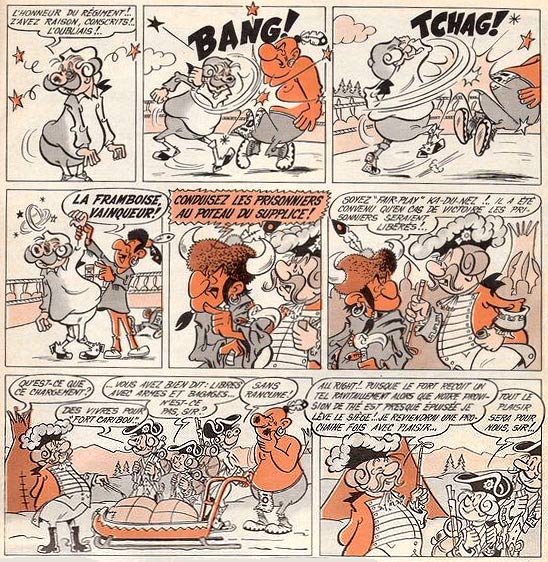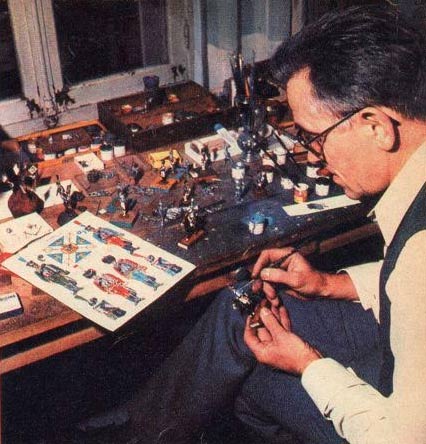'Wa-pi-ti, Enfant Sculpteur' (Dutch-language version from Kuifje #44, 30 October 1957)
Roland Venet, who worked under the signature of Rol, was a French cartoonist who created many comic strips and game pages for French newspapers and magazines from the 1940s through the 1960s. He drew short-lived comics like 'Mich et Mouche - Le Papillon de Lumière' (1957) and 'Dany' (1958) in the magazine Line and continued its title comic, 'Line'. With René Goscinny as scriptwriter, Rol also drew two humorous comics, 'Oscar Baudruche Mène L' Enquête' (1957) and 'Wa-Pi-Ti, Enfant Sculpteur' (1957). For Bayard Magazine, he drew 'Nénuphar' (1961-1962) and 'Flagada et Pipeau' (1962-1965). Later in his career, he was active as a colorist for publishing company Dargaud.
Early life and career
Roland Ernest Gabriel Venet was born in 1919, and additionally worked as a groom, archivist and animator. He was a longtime contributor of humorous drawings to magazines like Marius (1942-1961), Le Hérisson (1946-1955) and L'Almanach Vermot (1948-1962). His cartoons also appeared in Parisiana, L'Os Libre, La Presse, Boléro, Fou-Rire, Lectures pour Tous, V Magazine, and Le Chasseur Français. Rol illustrated advertisements with a little black boy called 'Chocorêve' for the Ibled chocolate factory in Mondicourt (near Calais). The character also appeared in a comic strip published in the newspaper La Voix du Nord between 1949 and 1959. Venet illustrated games and made the feature 'Adorable Nanette' for Atout Coeur in 1956, and later in Mode de Paris.
'Mich et Mouche' (Line #117, 1957).
Comics in Line
In the late 1950s, Venet was also present in Tintin and its sister magazine Line. In Line, he drew comic stories like 'Mich et Mouche - Le Papillon de Lumière' (1957) and 'Dany' (1958). From 1960 on, he also drew the magazine's title strip, 'Line', in 1957 created by Françoise Bertier and Nicolas Goujon, and continued by Charles Bugue and André Gaudelette in 1958. After Rol, Paul Cuvelier and Greg gave the character its final incarnation in 1962.
Comics in Tintin
From 1953 on, Rol made regular appearances in Tintin magazine, creating editorial illustrations. In 1957, Venet teamed up with scriptwriter René Goscinny to create the humorous series 'Oscar Baudruche Mène L' Enquête', about an unsuccessful detective, and 'Wa-Pi-Ti, Enfant Scalpeur', about a little Native American boy with a love for scalping. Around 1960, 'Wa-Pi-Ti' returned as a newspaper comic, also drawn by Rol, published in La Vie Catholique. Between 1958 and 1961, he became a regular provider of game pages in Tintin.
'Oscar Baudruche Mène l'Enquête' (Dutch-language version from Kuifje #40, 2 October 1957).
1960s comics
Rol drew a comic strip called 'Nénuphar' in Bayard magazine in 1961-1962. For the same publisher, Bayard, he drew several short stories of 'Flagada et Pipeau' for the magazine Record (1962-1965). They were set in 18th-century North America, where French and British troops clashed in their forts, assisted by their allies of the surrounding Native American tribes.
Final years and death
In the 1970s, Roland Venet gradually dropped most of his drawing activities, until eventually quitting the business in the 1980s. He started a new activity, making collectable toy lead soldiers, and became a painter. His final comic-related job was working as a colorist for Éditions Dargaud, among others on the 'Lucky Luke' albums by Morris and Goscinny. He was also active as a painter as a hobby. Venet passed away in 1997.
'Flagada et Pipeau'.
Homonym confusion
Rol is often confused with the artist J. L. Rochelle, who at some point worked in a similar drawing style. Rochelle drew for Editions Mondiales in the 1940s and 1950s, and later also made appearances in Fripounet et Marisette, Tintin and Coeurs Vaillants. According to Roland Venet's children, there is no connection between the two. Rol is also not the same artist as Rold, a cartoonist for the French press from 1950 to 1957 and whose real name is unknown.
Roland Venet, working on his soldiers (1969).









